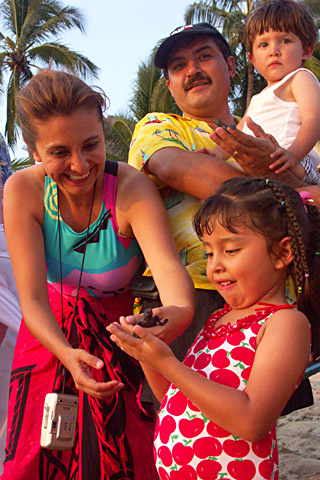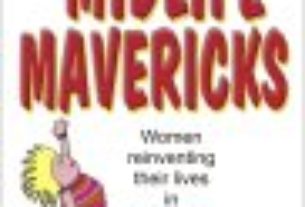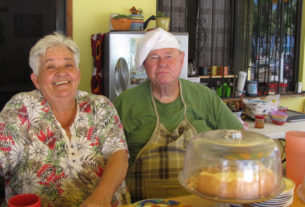At Home in Talpa de Allende, Jalisco
 MexConnect readers know by now that March is the month when everybody who can walk, walks to Talpa. It has become a tradition that has been passed down from generation to generation. The new short-cut through the mountains connecting Mascota to Puerto Vallarta has brought even more frequent visitors to Talpa de Allende.
MexConnect readers know by now that March is the month when everybody who can walk, walks to Talpa. It has become a tradition that has been passed down from generation to generation. The new short-cut through the mountains connecting Mascota to Puerto Vallarta has brought even more frequent visitors to Talpa de Allende.
Walkers come from all over Mexico. They may not walk all the way, but some walking has to be done to qualify the remark, “I went to Talpa in March.” At the entrance into Talpa there is a big arch going over the road. Cement versions of Virgin Mary have been donated by different towns such as Colima, Tepic, Zapopan, and others, and they line the wide sidewalk from the arch into town. Small flower gardens and resting benches are situated in front of some of the statues.
I’ve seen some of our “walkers” get out of a car at the arch, take off their shoes, and hobble in to the church as if they had walked all the way from Tequila or parts unknown.
It seems that in recent years we have more walkers coming in than in the past. September and October are also popular walking months, even though we’re still in the rainy season at that time. However, there was a lull last fall when heavy rains caused serious mudslides that blocked a portion of the road to Puerto Vallarta.
When Joel Sanchez was making the daily flight in his seven-passenger Cessna, we could guess what the weather conditions were in Puerto Vallarta by his arrival time. Since that service has been discontinued, and especially during the rainy season, we depend on the bus that leaves early in the morning to indicate what the road conditions might be.
We thought all was well until one day word came in that the road to Vallarta was closed due to a gigantic mudslide.
“How can that be? The buses are going out every morning as usual.”
“The Talpa bus goes to the mud slide. The Vallarta bus comes to the mud slide. All passengers get off and scramble over the mud, rocks and trees to get on the other bus and continue their journey,” my informer explained.
I could imagine old folks with walking sticks, mothers totin’ kids and bundles; all slipping and sliding through the muck and mire. What was a normal three-hour trip was now five to eight hours long. And yet, I was reminded of another trip through the mountains to the Puerto Vallarta beach taken by a family more than a hundred years ago before we had any road at all.
Herman A. W. Koch wrote of his Mexican vacation:
“I shall never forget the two trips we made to the seashore from Talpa. Here again, we went by horseback. We lived about sixty-five miles from the ocean and this meant two long days of horseback riding. On one of these trips my sister, Bertha, was too small to ride and had to be tied to the saddle. Whoever got the horse ready did not cinch the saddle tight enough. After we had been on the way most of the day, the saddle slipped around under the horse’s belly. Since she was tied and could not fall off, she struck her head on a rock, making a nasty gash over her left eye on her forehead. To keep her out of the hot sun, we would travel real early in the morning and again in the cool of the evening.
“I did not like traveling in the night, and I saw to it that I was not in the lead or bringing up the rear. We would ride single file and my place was in the middle of the procession. I did not like the howl of a tiger or mountain lion; wolves and coyotes were bad enough.
“We would spend two or three weeks at the seashore – bathing and just having a good time. We used to hunt turtle eggs. These big turtles can walk away with two big men on their backs and lay eggs as big as a hen’s egg, with a soft shell. When we found a turtle in the process of laying her eggs, we would scare her away and gather the eggs. We ate them when we were sure they were fresh. A turtle would dig a hole in the sand, lay her eggs, cover them up with sand and let the sun hatch them.
“One of my mother’s nephews, Primitivo Palomera, would swim way out beyond the breakers and I used to envy him. He was also a wonderful shot with a revolver and could hit a target a long way off.
“On these trips to the sea, we used to ride miles and miles through coconut groves. Here we would see parrots of all kinds, sizes and colors by the thousands. They would chatter and when in flight they would obscure the sun.”
I think Mr. Koch would be very disappointed to know those “thousands” of beautiful parrots that obscured the sun when he was a young boy disappeared long ago. It is a rare sight to see a parrot in its natural setting these days. The coconut groves gave way to civilization. I don’t know about tigers, but there are still mountain lions, coyotes and wolves about. We happen upon a startled doe and her fawn from time to time. Unfortunately, some locals think it great sport to hunt deer at night with blinding head lights and high caliber rifles.
Even thirty years ago, people in Puerto Vallarta spoke in whispers when they talked about eating turtle soup the night before. Today those sea turtles are well-protected and the Mexican navy guards and defends their hatcheries. It is a major emotional event to watch the baby turtles being carefully escorted to the sea for their first swim.
Photo by Josef Kandoll W. Josef Kandoll 2009


